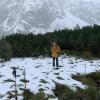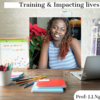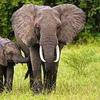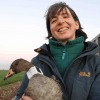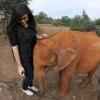Human-wildlife conflict and coexistence is a shockingly common problem, often with enormous consequences for both individual animals and entire populations.
When human-wildlife conflict comes to mind, you may immediately think of wildlife crime instead - which isn't wrong, since many regions with wildlife crime problems like poaching are also areas where people may frequently deal with human-wildlife conflict, causing the two issues to go hand-in-hand. But human-wildlife conflict is a much broader issue encompassing many ways that human presence and interference can cause problems for us and animals alike. Human-wildlife conflict includes:
- Elephants trampling a farmer's crops, resulting in retaliation
- New real estate developments infringing on ecosystems where predator species live, leading to predators having less territory and less food, which in turn leads to predators attacking domestic animals and livestock
- Freeways dividing the territory of animals like mountain lions, leading to wildlife venturing into neighborhoods or being killed by cars
- Lead bullets used in hunting causing scavengers like condors to die of lead poisoning
These are just a few examples of how humans can negatively impact wildlife, and it's clear to see how many of these scenarios could escalate. Human-wildlife conflict solutions don't just include ways in which we can prevent these issues (for example, through tracking predators, monitoring populations' territories, or building barriers and wildlife crossings monitored by sensors), but also the ways in which we can help people connect with wildlife and care about learning to live alongside them.
If you're interested in solutions that can prevent human-wildlife conflict, join this group and get to know the people who are working to protect and save species around the world!
Header image: Casey Allen on Unsplash
No showcases have been added to this group yet.
- @shahselbe
- | he/him
Conservify
Conservation Technologist, National Geographic Explorer, and Founder of Conservify and FieldKit

- 0 Resources
- 5 Discussions
- 18 Groups
- @WakioMwandoe
- | She/her
I am a GIS Analyst currently working at Center for Ecosystem Restoration Kenya, a non-profit whose vision is to restore resilient and thriving ecosystems. I have a Bachelor's degree in Geoinformation Technology and I am looking to explore applications of GIS in Conservation.
- 0 Resources
- 0 Discussions
- 7 Groups
- 0 Resources
- 0 Discussions
- 3 Groups
- 0 Resources
- 0 Discussions
- 8 Groups
BSc Graduate looking for volunteering/work in conservation biology
- 0 Resources
- 0 Discussions
- 4 Groups
- @somak
- | He/Him
Mechanical Engineer with a masters in environmental monitoring, modelling and reconstruction.
- 0 Resources
- 4 Discussions
- 2 Groups
Fauna & Flora
- 0 Resources
- 0 Discussions
- 6 Groups
- @guitarfishmasum
- | He/His
Wildlife Conservation Society (WCS)
Wildlife Biologist and Marine Conservationist
- 0 Resources
- 0 Discussions
- 18 Groups
- @marusuffern
- | She/her
Passionate and curious about nature and its diversity, I seek to learn more about conservation, new technologies, and the unknown and infinite environmental world.
- 0 Resources
- 0 Discussions
- 17 Groups
I am an interdisciplinary scientist with robust experience in natural resource utilization, coexistence, conflict analysis and management, peacebuilding and mediation, wildlife farming and conservation, and dryland and rangeland management.
- 0 Resources
- 0 Discussions
- 6 Groups
Iam very passionate in environment as well as wildlife conservation
- 0 Resources
- 1 Discussions
- 8 Groups
- 0 Resources
- 0 Discussions
- 7 Groups
Article
The internet has a long love affair with cat pictures, but these aren’t your mom’s internet cats. Now internet cats are getting even bigger and wilder. In this article, Dr. Lisa Feldkamp talks about the work Panthera is...
26 October 2016
Holohil Systems is now accepting applications for grants to support the purchase of wildlife tracking equipment of up to CDN $2,000 from the Holohil's own product line. Applications are welcome from any geographical...
20 July 2016
Sharing personal 'best of' animal pictures is a favorite pastime of many camera trappers. A prolific camera trapper himself, Roland Kays has pulled together more than 600 images collected by 152 researchers from 54...
18 July 2016
Article
Drones are being explored for a spectrum of applications in conservation that include mapping, biodiversity inventories, antipoaching patrols, wildlife tracking and fire monitoring. However, questions remain about...
8 July 2016
More than half of all primate species are endangered, including our closest living relative, the chimpanzee. Could Passive Acoustic Monitoring (PAM) be applied to primates as well as it has been for other taxa? In this...
29 June 2016
Operating the largest tropical forest camera trap network globally, TEAM Network has accumulated over 2.6 million images. How can large datasets coupled with new techniques for data management and analysis provide...
28 April 2016
Margaret Driciru, Senior Warden & Wildlife Veterinarian with the Uganda Wildlife Authority, showcases how mobile reporting technology is being used in the field to monitor, collect data, and send rapid alerts when...
22 December 2015
Katherine Chou, Product Lead at Google[x] Labs, sees technology as a way to make the impossible, possible. She explores differences in how wildlife NGOs and the tech sector think and plan, and what the conservation ...
22 December 2015
Gary Atkinson, Director of Emerging Technologies at ARM, explains why we should be interested in the Internet of Things. Could it be a game changer for conservation?
10 December 2015
October 2025
event
May 2023
event
April 2023
32 Products
3 R&D Projects
42 Organisations
Recently updated products
Recently updated R&D Projects
Recently updated organisations
| Description | Activity | Replies | Groups | Updated |
|---|---|---|---|---|
| Thank you for these details. I was about to ask the issues with different substrates. Now I understand the limitations and possibilities. Yeah, I agree that each of these... |
|
Human-Wildlife Coexistence | 5 years 1 month ago | |
| Hi @Tim+Vedanayagam Thank you for posting this. I'd be happy to contribute to the thermal sensing work under way. Can you confirm - have you built a thermal AI model... |
|
Human-Wildlife Coexistence | 5 years 4 months ago | |
| A neoteric solution:- ADSMO(HWC): https://youtu.be/yG0Z5HaL_tc |
|
Human-Wildlife Coexistence | 5 years 8 months ago | |
| Hi everybody! The IUCN Species Survival Commission (SSC) Human-Wildlife Conflict Task Force, the Global Environment Facility-funded and... |
|
Human-Wildlife Coexistence | 5 years 9 months ago | |
| Thanks Drue for your valuable input. This is certainly not to encourage killing venomouse snakes. We can actually incorporate the featurs you pointed out to save venomouse... |
|
Human-Wildlife Coexistence | 5 years 10 months ago | |
| Tusk are illegally traded by the poachers for earning profit out of it. This needs to be stopped. |
|
Human-Wildlife Coexistence | 5 years 11 months ago | |
| Hi Aditya, If you haven't already found it, you should check out our last virtual meetup, it was all about tools and spaces for collaboration and we featured a number... |
|
Human-Wildlife Coexistence | 6 years 2 months ago | |
| Cool idea Ashwan. Looks similar to the virtual parks idea that Laurens is leading. Have you seen it? Also check out rewilding.io and get an entry in to the contest! |
+30
|
Human-Wildlife Coexistence | 6 years 5 months ago | |
| A very good summary all-round Nilanga. Only a wholistic approach can truly resolve conflict. |
|
Human-Wildlife Coexistence | 6 years 6 months ago | |
| Hi all, We often think about complicated tools when people refer to the use of tech in conservation. But mobile phones can be highly... |
|
Human-Wildlife Coexistence | 6 years 6 months ago | |
| Thanks both for your comments, very interesting indeed! Also great to hear that so many people are eager to get involved in this kind of research and will participate with great... |
|
Human-Wildlife Coexistence | 6 years 6 months ago | |
| Dear Femke, I am actually looking for studying the crop damages using drones and also tracking the movements, may be using GPS collars. But I do not actually know about these... |
|
Human-Wildlife Coexistence | 6 years 7 months ago |






